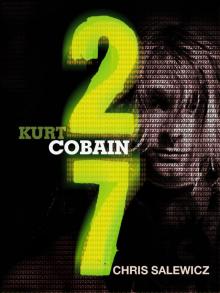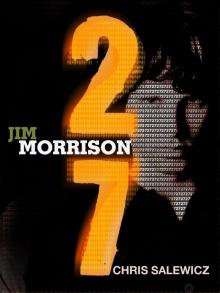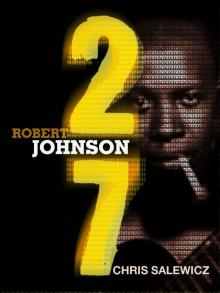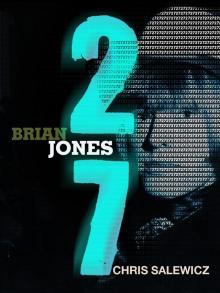- Home
- Salewicz, Chris
27: Kurt Cobain Page 2
27: Kurt Cobain Read online
Page 2
At his father’s insistence, Kurt had played in a local baseball league – as unwilling as he had been about wrestling. Another member of the team was a boy called Matt Lukin. It turned out that Lukin, like Kurt a student at Montesano High, was also a prospective musician, playing bass in a local group called the Melvins.
Kurt went to a Melvins rehearsal, and got drunk. But he also experienced an epiphany: these guys had actually managed to put a band together …
Having started out as Who copyists, the Melvins by now were playing furiously paced hardcore punk, sometimes performing shows as far afield as Seattle. When other groups began to play in a similar style, the Melvins altered utterly, playing everything at an impossibly slow, doomy pace, into which – sacrilege! – they began to inject elements of heavy metal. The Melvins thereby became the forerunners of what transmogrified into grunge, exemplified on their Gluey Porch Treatments album, released in 1987, often cited as the first grunge album.
As fate would have it, it transpired that Buzz Osbourne, the leader of the Melvins, was in the same art class as Kurt at Montesano High School – although he was a couple of years older. Osbourne owned a book about the Sex Pistols, which Kurt avidly devoured, inking the group’s distinctive logo onto desks and exercise books. Kurt Cobain had decided that somehow he would start a punk group.
Finding it difficult to get on with his father’s new family, Kurt moved back to Aberdeen to live with his uncle Chuck: his mother had broken up with the boyfriend and had also lost her job, so she asked Chuck to care for her son. Kurt shuffled between relatives, including his father’s parents and three different sets of aunts and uncles, moving back and forth between Aberdeen and Montesano, regularly swapping high schools. How, you cannot help wondering, would this have exacerbated Kurt’s mounting sense of insecurity and anger?
In 1983 Kurt moved back to his mother’s place. Yet returning to his maternal home was not an easy experience. There were always guns around. In 1984, his mother suspected that Pat O’Connor, her new longshoreman husband, had cheated on her. Wendy came home drunk and grabbed one of Pat’s several guns, intending to shoot him[8]. Fortuitously, she found herself unable to load the weapon. In the end, Wendy collected all Pat’s rifles and pistols, took them down to Aberdeen’s Wishkah River, and threw them in. Kurt watched as his mother did this. The next day he fished out of the water as many of the weapons as he could, and – in what could be seen as a symbolic twist – purchased his first professional amplifier with the proceeds from selling the guns.[9]
At Aberdeen High School, Kurt met a boy called Krist Novoselic. Blessed with a satirical mind-set, Krist was extremely funny. Sometimes Kurt felt he was the only person who appreciated his uncompromising sense of humour. In Aberdeen, Krist was known as Chris, but in 1992 he legally changed it back to his Croatian name. Krist had been born to Croatian immigrant parents on 16 May 1965, in Compton, the sometimes notorious south-central district of Los Angeles, where from an early age being streetwise was a necessity for survival. In 1979, Krist’s father, who had been driving a delivery truck in Southern California, learned that there was cheap property to be had in Aberdeen, Washington, where there was a significant Croatian community, as well as regular work in the local lumber mills. When they moved to Aberdeen, Krist Novoselic, by now a relatively sophisticated Los Angeleno, could not find any local kids with whom to empathize. Among other things, he was physically huge, eventually growing to 6’ 7”. The local teenagers were into Top 40 radio, while Krist dug Led Zeppelin, Black Sabbath, Devo.
By late spring 1980, his parents had made a radical decision to send their eldest son for a stay in their homeland, which was still a region of communist Yugoslavia. Becoming fluent in Croatian while there, Krist benefited from the excellent standard of education enjoyed in the communist bloc. He also discovered the Sex Pistols and the Ramones. Their music was released in Yugoslavia, which also had a strong national music scene, as Krist discovered.
But when he returned to Aberdeen, he found his parents had divorced. He also learned that the city’s isolation meant he was almost alone in his understanding of punk. ‘It was hard for punk to make its way to Aberdeen because of its geographic isolation,’ he told Everett True. To earn money Krist took a job at Taco Bell, saving for a vehicle and musical instruments and equipment.
Kurt Cobain, who by now would always wear a grey trench coat, first became friends with Krist’s younger brother Robert. The first time he visited their home, Krist was upstairs, playing punk music. Although he was a couple of years older than Kurt, the younger boy quickly registered his presence and immediately ‘got’ him. Krist was, Kurt said, a ‘really clever, funny, loudmouth person everyone laughed at, even though he was smarter than them.’[10]
Yet they did not immediately become close friends. In fact, as always seemed to be the case, there was hardly anyone at Aberdeen High with whom Kurt felt he could empathize. Eventually, he began to hang out with the school’s stoners, who were at least into rock’n’roll. Among them was a kid called Dale Crover. Crover had just become the new drummer with the Melvins, who began to rehearse at Crover’s parents’ Aberdeen house. Kurt Cobain again found himself in the inner orbit of the Melvins, for whom he even auditioned at one point. ‘I totally botched it. I was so nervous that I forgot all the songs. I literally couldn’t play a note. I just stood there with my guitar and played feedback with a blushed face.’[11] Yet the Melvins’ discipline and belief in rigorous hard work hit a nerve in Kurt, who vowed to himself to emulate them.
Kurt and Krist Novoselic would run into each other at Melvins’ rehearsals. Kurt discovered that Krist played guitar, and they would hang out and play music together.
On a punk rock compilation tape that Buzz Osbourne had put together for him, Kurt discovered Black Flag, and its iconic singer Henry Rollins. Suitably inspired, in August 1984 he sold his record collection to pay for a trip to Seattle to see Black Flag. ‘Becoming a punk rocker fed into my low self-esteem because it helped me realize that I don’t need to become a rock star – I don’t want to become a rock star … I’m so glad that I got into punk rock at the time I did because it gave me these few years that I needed to grow up and put my values in perspective and realize what kind of person I am.’[12]
In 1993, Kurt Cobain expanded on this theme: ‘[Buzz] made me a couple of compilation tapes, Black Flag and Flipper, everything, all the most popular punk rock bands, and I was completely blown away. I finally found my calling. That very same day, I cut my hair, and I would lip-synch to those tapes. I’d play them every day. I’d already been playing guitar by then for a couple of years, and I was trying to play my own style of punk rock, what I thought it would be. I knew it was fast, and had a lot of distortion. It expressed the way I felt politically and socially. It was the anger that I felt, the alienation.’[13]
Although he had got into more conventional rock acts, like Led Zeppelin and Aerosmith, sensitive Kurt could detect that something was awry in their entire stance. ‘I really did enjoy and do enjoy some of the melodies they’d written, but they were definitely lacking something, and it took me so many years to realize that a lot of it had to do with sexism, the way that they just wrote about their dicks, having sex. That stuff bored me,’ he told Jon Savage.
Surprised at such a perception, Savage asked Kurt for the origins of such thinking – did it evolve from punk rock? No, he replied, his innate sense of injustice had been sparked earlier. ‘It was before that. Because I couldn’t ever find any good male friends, I ended up hanging out with the girls a lot, and I just felt that they weren’t treated equally, weren’t treated with respect, the way Aberdeen treated women in general. They were just totally oppressed, the words “bitch” and “cunt” would be totally common. But it took me many years after the fact to realize those were the things that were bothering me. I was just starting to understand what was pissing me off so much, and within that year, the last couple of years of high
school, and punk rock, it all came together. I finally admitted to myself, I am not retarded.’
From around the time he turned fourteen, Kurt was smoking marijuana every day. By the time he was in his senior year, he started to ease off and ultimately quit altogether for a time, aware that the drug exacerbated the paranoia to which he was already prone. He also became a pot-smoking buddy of a kid called Myer Loftin, drawn to him because he was into similar music. What Kurt did not know at first was that Loftin was gay, which led to other students at Aberdeen High assuming that Kurt was also. Although this was not the case, he would be bullied – taking a couple of beatings – for this. ‘I even thought that I was gay. I thought that might be the solution to my problem. One time during my school years, although I never experimented with it, I had a gay friend, and that was the only time that I ever experienced real confrontation from people, because for so many years … they were basically afraid of me, and when I started hanging out with this person who was known to be gay, I started getting a lot of shit. People trying to beat me up and stuff. Then my mother wouldn’t allow me to be friends with him anymore. ’Cos she’s homophobic. It was real devastating, because finally I’d found a male friend who I actually hugged and was affectionate to, and we talked about a lot of things. Around that same time, I was putting all the pieces of the puzzle together. He played a big role in that.’[14]
Ultimately, this led to Kurt having an especially sophisticated view of sexuality. In his Nirvana lyrics, Kurt would often say the unsayable: ‘Everyone is gay!’ he declared, on ‘All Apologies’ – a song that also contains the lines, ‘Everything is my fault / I’ll take all the blame.’
Once again, Don Cobain decided to intervene in his son’s life, and try to put it back on course. Kurt was persuaded to move back to Montesano, where his father cajoled him into sitting an entrance exam to serve in the US navy. Kurt passed the test with flying colours, but refused to sign up to be a sailor.
Returning to Aberdeen, Kurt moved in with Jesse Reed and his family. Jesse was a friend whose born-again Christian parents endeavoured to set him on what they considered to be the correct path in life. Jesse’s father, Dave, had an unconventional past as sax player in the Beachcombers, a 1960s garage group. Although he would be obliged to attend church with Jesse’s parents, they provided a stable home life for Kurt. At the age of seventeen, under the Reeds’ influence, Kurt was baptized. For a few weeks he declared he was a Christian. Kurt was looking for something. Something he never really found. But at least he felt a little more self-confident. In August 1984, Kurt had sex for the first time.[15]
On his eighteenth birthday, on 20 February 1985, the Reeds threw a party for him at their house. As a present, his aunt Mari gave him Stephen Davis’s Hammer of the Gods, a revelatory, warts-and-all Led Zeppelin biography. Kurt was touched. ‘… it was nice to know people care about ya,’ he wrote to her in his thank you letter.
By now Kurt’s life mainly consisted of smoking large amounts of marijuana. Three months later, realizing that he was way behind on graduation credits, Kurt dropped out of high school, only weeks before he was due to have graduated. Somehow, he had decided, he would make his future in music. A high school dropout? You can’t get lower than that in America. Considering his low self-esteem, such loser status may well have appealed to Kurt.
Despite the Reeds’ generosity towards him, something of the feral seemed to have developed in Kurt. On one occasion when he forgot his key, he smashed a window to get back into their house. And was summarily told to leave.
Kurt briefly moved back to his mother’s. After Wendy had told him that if he didn’t get a job, he would have to move out, Kurt moved into an apartment with Jesse Reed. Ironically, in order to pay for this, he did get a job, working at a restaurant on the coast, then returning to Aberdeen High – as a janitor. Going back to his high school in such a lowly role sapped him psychologically, and after two months he quit.
He then turned on Jesse. After defacing Jesse’s high school yearbook – a rebuke to Jesse for having graduated? – Kurt kicked him out of the apartment, which they had shared for three months. Kurt hung on to the place. Eventually, he ran out of money and, in autumn 1985, was obliged to up sticks. Broke and homeless, Kurt slept wherever he could: in the local library; on his mother’s porch. Although there is an element of self-mythologizing here, it’s true that he very occasionally slept under the North Aberdeen Bridge, near his mother’s place. The bridge crossed the Wishkah river, and Kurt prided himself on his ability to catch fish from its waters, which he would then eat. (Later he was told that the Wishkah was so polluted that any fish caught in it were certainly poisonous.)
That winter of 1985, Kurt put together his first group, to which he gave the cartoon-like hardcore name of Fecal Matter. Playing his own material, Fecal Matter also consisted of his friend Dale Grover on bass and another boy, Greg Hokanson, on drums. On one occasion they managed to secure a support slot with the Melvins, playing a Washington state coastal town. But Kurt and Dale Grover could not get on with the drummer, and decided to concentrate on recording together. Driving up to Seattle, they paid a visit to Kurt’s aunt Mari, who owned a four-track TEAC tape recorder. Mari was amazed at how angry Kurt’s vocals were, on tunes with such titles as ‘Bambi Slaughter’, ‘Laminated Effect’, ‘Sound of Dentage’ and ‘Downer’, a different version of which would appear on Bleach, the first Nirvana album. The sound of these tunes was like a cross between the Melvins and Metallica, reliant on heavy riffing and largely devoid of melody.
Later, with Buzz Osbourne on bass and Mike Dillard, once of the Melvins, on drums, Kurt practiced the Fecal Matter material, but eventually this project evaporated.
For around eight months, Kurt moved into the home of his friend Steve Shillinger. Shillinger’s father taught English at Aberdeen High, and taking in waifs and strays was commonplace for the family. However none had ever stayed as long as Kurt did, who kept his sleeping bag behind the couch on which he slept. During this time, Kurt Cobain embarked on a side career as a graffiti artist. Largely this consisted of absurdist gestures, such as spray-painting ‘QUEER’ on trucks bristling with rifle-racks. Once he was picked up by the police and fined for such behaviour. (In his pocket when he was busted was a copy of a cassette by hardcore outfit Millions of Dead Cops.)
In 1986 Kurt managed to play his first live show, in a performance space in the state capital Olympia, fifty miles east of Aberdeen. Buzz Osbourne was on bass, and Dale Crover played parts of a drum kit, as Kurt recited some of his poetry over their instrumental backing – he had had to get drunk to do so. But local groovers Dylan Carlson and Slim Moon were impressed, telling Kurt afterwards how great the show had been. Kurt also started to hang out with a local drug dealer, and in the middle of the summer, this character shot Kurt up with heroin. This was the first time he had ever experienced the drug. ‘It was such a scarce thing to find heroin in Aberdeen that I just thought I would try it,’ he said.[16]
As her son was still essentially homeless, his mother put down the initial $200 deposit on a rundown wooden house at 1000 East Second Street in Aberdeen, near to where she lived. Melvins’ bassist Matt Lukin moved in with him – useful, as Lukin was a carpenter, and plenty of work needed to be done on the two-bedroom property. Not that Lukin’s efforts were always noticed. By the time that Kurt had been living there for only the briefest time, the place looked like a parody of a teenage apartment – the floor was littered with empty beer cans and it stank. In the bath Kurt installed a family of turtles, raising the question as to where he actually washed.
Despite having taken a job as a janitor at a resort hotel – he spent most of his time sleeping in the rooms – Kurt was still always broke. By now a seasoned drug user, he needed to find a cheap high, and soon discovered the opiate properties of assorted cough syrups.
That winter, however, Kurt badly burned his left hand. He had been cooking French fries and managed to co
ver his hand in boiling fat. At first he was told he would never be able to play the guitar again. While he recuperated he was unable to work, which meant he had even less money than previously. Rice was almost all he could afford to eat. Yet he was able to play guitar, and spent most of the several months of his recovery improving his skills on the instrument.
During this time, for about a month, Kurt also began to rehearse with Krist Novoselic, playing with a local drummer called Bob McFadden. Together they would travel to Olympia, which lay on the Puget Sound waterfront and was respected as a regional centre for the arts. There, Kurt had discovered another musical scene altogether, one of a relative sophistication that was largely drug-free. Its focus was K Records, an indie label. K was also a local distribution network for British indie acts such as the Vaselines, Young Marble Giants and Kleenex. K was run by Candace Peterson and Calvin Johnson. Johnson’s band Beat Happening were the kings of this self-consciously naïf scene, which prided itself on its geeky, nerdy nature, in which everyone – unlike Kurt with his long blond tresses – had short hair. Free-thinking and bohemian, everyone around this scene played in each other’s groups. Kurt was very taken with the notion of K Records, and had its logo tattooed on his left arm. ‘K Records and that whole scene in Olympia turned me on to so much amazing music. The Pastels and the Vaselines and all that stuff. Every couple of years I feel that I’ve gone as far as I can with being introduced to something new, and then something like that hits me and it gives me life for a few years … I was turned on to the whole 4AD thing, the Raincoats and the Young Marble Giants. It was like the first time that I heard punk rock, ’cos there were all these bands from the last fifteen years, and I’d try to find all these records, and it was a whole scene, these bands that had been going on for like ten years, and it had the same impact on me. It was a completely different world.’[17]

 27: Kurt Cobain
27: Kurt Cobain 27: Jim Morrison
27: Jim Morrison 27: Robert Johnson
27: Robert Johnson 27: Brian Jones
27: Brian Jones